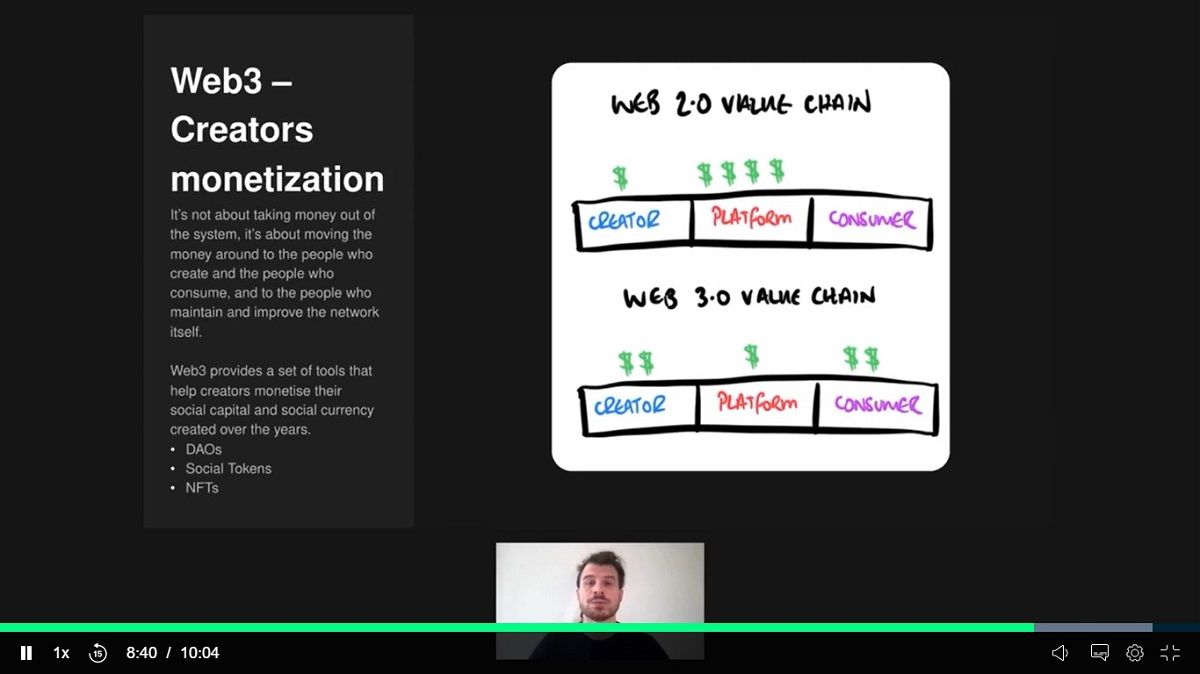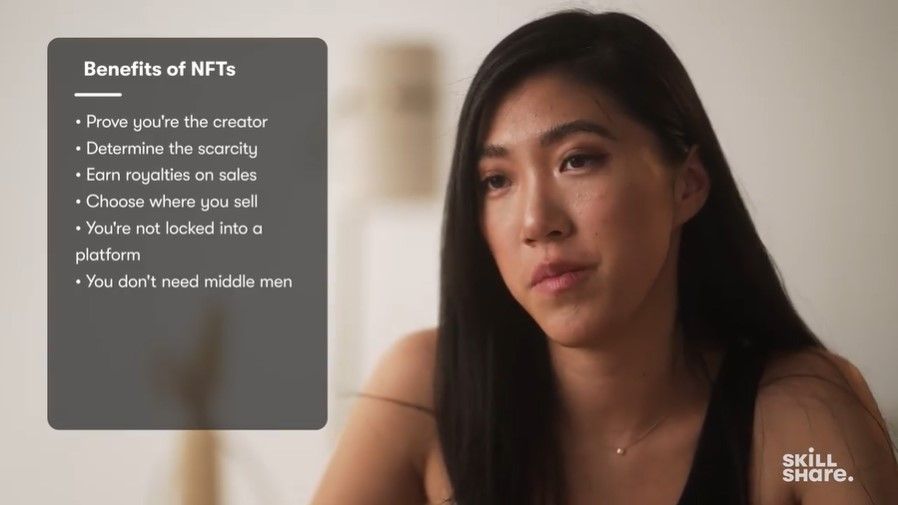The internet is buzzing about Web3. If you don’t know what that is, you’re not alone. Generally speaking, it’s an abstract term to describe the directions in which our online interactions are heading.
Whether you’re a digital creative, somebody who interacts with the internet for work, or just someone who enjoys browsing the web, having some understanding of Web3 early on will help. Fortunately, Skillshare has your back. Here’s how you can build a Web3 curriculum on Skillshare.
What Is Web3?
Don’t let the experts fool you. For the most part, the move to Web3 is going to be gradual. And it’s only just begun. Chances are, you’ve already engaged with some Web3 interfaces.
For the most part, Web3 relies on blockchain technology as a way of proving ownership and sending peer-to-peer transactions. Web3 also relies on the prevalence of low-and-no-code creator tools. Between these two things, it will be easier than ever for people to create digital content and for them to make money from that content.
You may have also heard of Web3 through the context of “the spatial web” and “the metaverse.” Virtual spaces aren’t necessarily a part of Web3, but they seem to be along for the ride because of long-standing problems with virtual spaces that Web3 happens to solve.
First, virtual spaces have largely been too complicated for non-specialist developers to create. Further, once users entered one of these virtual spaces, they were more-or-less stuck because they couldn’t transfer their assets and identity. No-and-low-code programming makes virtual spaces more producible, and blockchain makes them more navigable and profitable.
So, if you’ve been following along, the building blocks of Web3 are:
- Blockchain and Cryptocurrencies
- Decentralized monetization and governance.
- 3D Design (starting with low-and-no-code)
Do you need to know how to do all of these things? That depends on the kind of role that you want to play in Web3. If you just want to engage with Web3, you should still at least be aware of these things.
If you want to be a content creator, you should have a working knowledge of Blockchain, and low-or-no-code creator tools. If you want to be a “world builder” sculpting the spatial web and the metaverse, you should have a working knowledge of all these things and explore more robust creator tools.
Survey Courses
The first stop on the Skillshare campus is a Web3 class. That’s right; you can just search “Web3” classes if you want to. These are your “survey courses” that offer a thousand-foot-view of the whole Web3 philosophy and ecosystem, but don’t usually do much for developing particular skills and interests.
The “Web3 Crash Course” presented by Matteo Mosca and Josh Snow is an entry-level course on Web3 itself. It starts out explaining what Web3 is and how Web3 differs from Web2 and Web1. It doesn’t necessarily explain how the underlying technologies work, focusing instead on the ramifications of their working.
From there, the presenters go through examples of live Web3 projects, including both good and bad examples. Finally, the presenters go into launching decentralized apps with low-and-no-code builders. They only cover one or two tools, so it’s an interesting example, but might not be deep enough for aspiring creators.
There are 11 videos in this course, most of which are between six and eleven minutes long. If you watch all 11 videos, you will spend just over two hours learning how to launch decentralized apps. Most casual Web3 users could probably get everything they need by watching sessions two through five, and eight.
Blockchain Courses
From there, you’ll want at least one blockchain class. Maybe two.
Most of the classes either treat blockchain as a technology but don’t really talk about cryptocurrency or discuss cryptocurrency without addressing wider blockchain technology. You can pick one type of class or the other if you want to specialize in crypto trading or in decentralized apps, but it might be handy to take two classes.
Blockchain Fundamentals
Blockchain: Fundamentals, Types, and Industry Use Cases is a relatively hefty class, clocking in at over four-and-a-half hours in total length. However, that’s spread across 61 highly digestible courses, usually between three and eight minutes each.
With a technological focus, the course breaks down blockchain into popular cryptocurrencies and smart contracts. The course talks about what exchanges are, but doesn’t really get into the nuts and bolts of buying and selling crypto.
Demystifying Cryptocurrency
Demystifying Cryptocurrency: Understanding Bitcoin and Beyond, presented by CoinShares Chief Strategy Officer Meltem Demirors, covers some of the same ground, but with a more concentrated focus on the currency aspect. The full course is just over one hour, across ten lessons, most being between six and eleven minutes.
If you skip Blockchain fundamentals, this class will still cover what blockchain is and how it works, but much less rigorously. It talks more about terminology specifically as it relates to cryptocurrency, but largely glosses over other blockchain applications like smart contracts.
Decentralized Monetization and Governance
In your blockchain courses, you hopefully heard about smart contracts. This is the technology behind non-fungible tokens, as well as Web3 governance structures like decentralized autonomous organizations and decentralized applications.
DApps
DAPPS: Create a Decentralized Application is a fifty-minute course in nine lessons, with the longest being a little over ten minutes. The first three lessons give an overview of blockchain and describe DApps and smart contracts. The remaining lessons in the course walk through how to create smart contracts and DApps.
NFT Art
Digital artist Pplpleasr presents NFT Art: Make and Mint Your First Digital Asset. Just over one hour in length, the course consists of 13 classes between two and eleven minutes, with most between four and seven minutes.
Even people who want to buy but do not necessarily make NFTs should probably watch the first six episodes that discuss blockchain, Web3, Ethereum, smart contracts, wallets, and marketplaces. The rest of the series discusses creating, minting, and selling NFTs, as well as growing a community in the space.
3D Design
If you just want to buy and sell in Web3, explore the other course directions in this article. If you want to be a creator, you’ll need to explore 3D design. Tools range from no-code tools for simple art pieces to low-code tools with more capability, to whole programming languages.
There are a lot of other important elements like Three.js and A-Frame. The suggested courses below illustrate the different levels of design complexity in Web3.
Blender
Blender is a tool for creating relatively simple 3D models of objects and even characters. Arash Ahadzadeh gives you an introduction in Blender 3D: Design 3D Characters in Blender From Scratch.
This course runs just under two hours over sixteen courses. The longest is a half-hour marathon session, but most run under ten minutes and consist of designing different parts of a complete character. So don’t feel like you need to do the whole course at once.
Unreal Engine
Unreal Engine was created for making video games, but it’s also widely used for creating scenes and effects. That’s what Jordy Vandeput focuses on in his class, Unreal Engine 5 for Beginners: Learn the Basics of Virtual Production. This is a more intensive course consisting of about five hours of video over 25 lessons, most over ten minutes long.
If you do want to focus on game design, there are classes specifically for game design. However, a lot of the lessons will carry over. A class on virtual production may be more welcoming and more versatile.
Unity (and C#)
For those interested in an even more hands-on design platform, there’s The Ultimate Guide to C# and Unity. The course by Michael Murr pushes nine hours over 41 lessons, most between ten and twenty minutes. Learners learn the C# coding language and the ins and outs of the Unity Game Engine by creating their own 3D game.
Build Your Own Web3 Curriculum in Skillshare
This isn’t a degree course; it’s just recommendations. Mix and match episodes from classes. If you see a class that seems more interesting, take that instead. There’s a lot in Web3, and there’s a lot on Skillshare, so don’t let these suggestions limit you.



